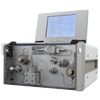 Dmitri Mendeleev, born in 1834 is Russia, was incredibly passionate about Chemistry and wanted to better organise the field.
Dmitri Mendeleev, born in 1834 is Russia, was incredibly passionate about Chemistry and wanted to better organise the field.
This determination led to his discovery of the periodic law and his creation of the periodic table of 56 elements which was organised by relative atomic masses.
The periodic table has iconic status and is instantly recognisable. Using this new table Mendeleev predicted the existance and properties of new chemical elements. When these elements were discovered he was guaranteed a place in the history of science! Three of these were actually discovered within his lifetime.
Below is an image of how the table first appeared when presented by Professor Menschutkin to the Russian Physico-chemical society (Mendeleev was unwell and not able to do this himself at the time). The exciting new ideas were soon published in the main German chemistry publication of the time, Zeitschrift fϋr Chemie
 On today, what would have been Mendeleev’s 182nd birthday, we celebrate his work. We can also celebrate the additional 62 elements that have been added to the original table.
On today, what would have been Mendeleev’s 182nd birthday, we celebrate his work. We can also celebrate the additional 62 elements that have been added to the original table.
On reading more about this great Chemist today around the web we found a great article in the Independant which gives us 5 little-known facts about him that we thought you might find interesting too!
-
Element 115 exists for less than a second
Ununpentium, an extremely radioactive element also known as element 115, has a half life of only 220 milliseconds. It was declared a new element in December 2015 after it was discovered by a group of Russian nuclear scientists.
-
Mendeleev loved card games
Thanks to his passionate love of solitaire, Mendeleev wrote the weight for each element on a seperate index card and then laid them out as if he was playing a card game. Logically, he figured elements with similar properties would form a “suit” which would then be placed in columns ordered by atomic weight.
- He predicted elements that had yet to be discoveredOne of the most genius-like things Mendeleev did with the periodic table was leaving gaps where he knew elements would exist, but they just hadn’t been discovered yet. With this in mind he managed to work out the weight of gallium, scandium, and germanium.
-
Some of the atoms can ‘kiss’
Take a modern periodic table, cut out the complex middle columns, and fold down the middle of the group 4 elements. The groups that meet, or kiss, have complementary electron structures and will slip together, combining with each other.
-
Radioactive elements like to move
Mendeleev got a lot of things right, but he didn’t clock that all elements are unchanging. Radioactive atoms have unstable nuclei which means they move around the chart.
Uranium, for example, decays into a series of lighter elements, including lead, a completely different element number.
Image below: A commemorative stamp collector’s miniature sheet showing some of Mendeleev’s original notes. Horizontal lines like Cr, Mo and W (in the third row down) correspond to today’s groups. Note the date, 17 February 1869. (Click the image below to see the original article on the RSC website which has some fantastic additional facts and statistics)
 As a little bit of an outside to the world of chemistry (unlike our sales team!) I find it fascinating to learn more about where our current world really comes from and I’m slightly ashamed to admit that, until today, I’d never heard of this very special individual. It just goes to show how important it is to be part of a team where all of our knowledge and skills can be pooled! Perhaps you’d like to join in the fun?
As a little bit of an outside to the world of chemistry (unlike our sales team!) I find it fascinating to learn more about where our current world really comes from and I’m slightly ashamed to admit that, until today, I’d never heard of this very special individual. It just goes to show how important it is to be part of a team where all of our knowledge and skills can be pooled! Perhaps you’d like to join in the fun?




